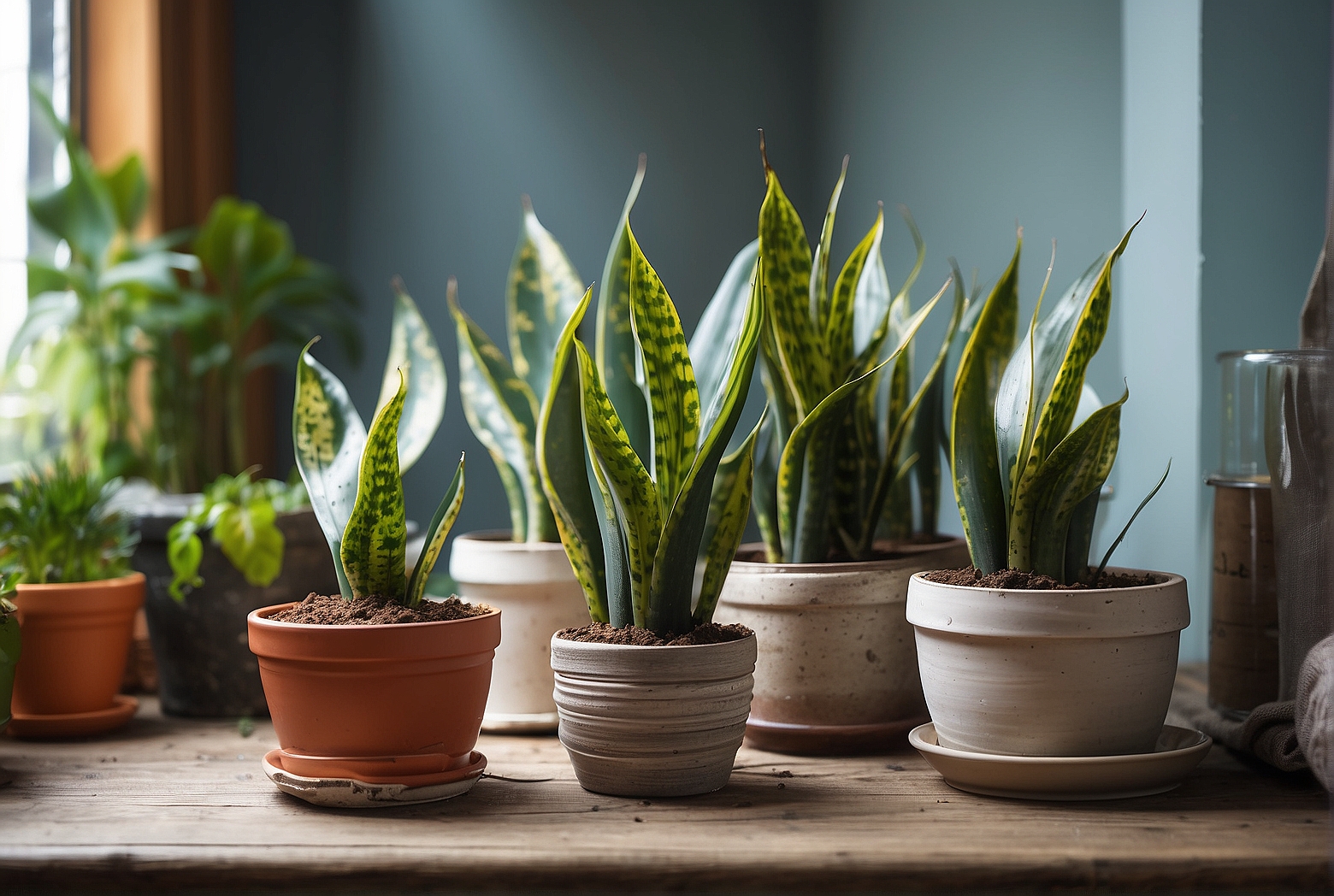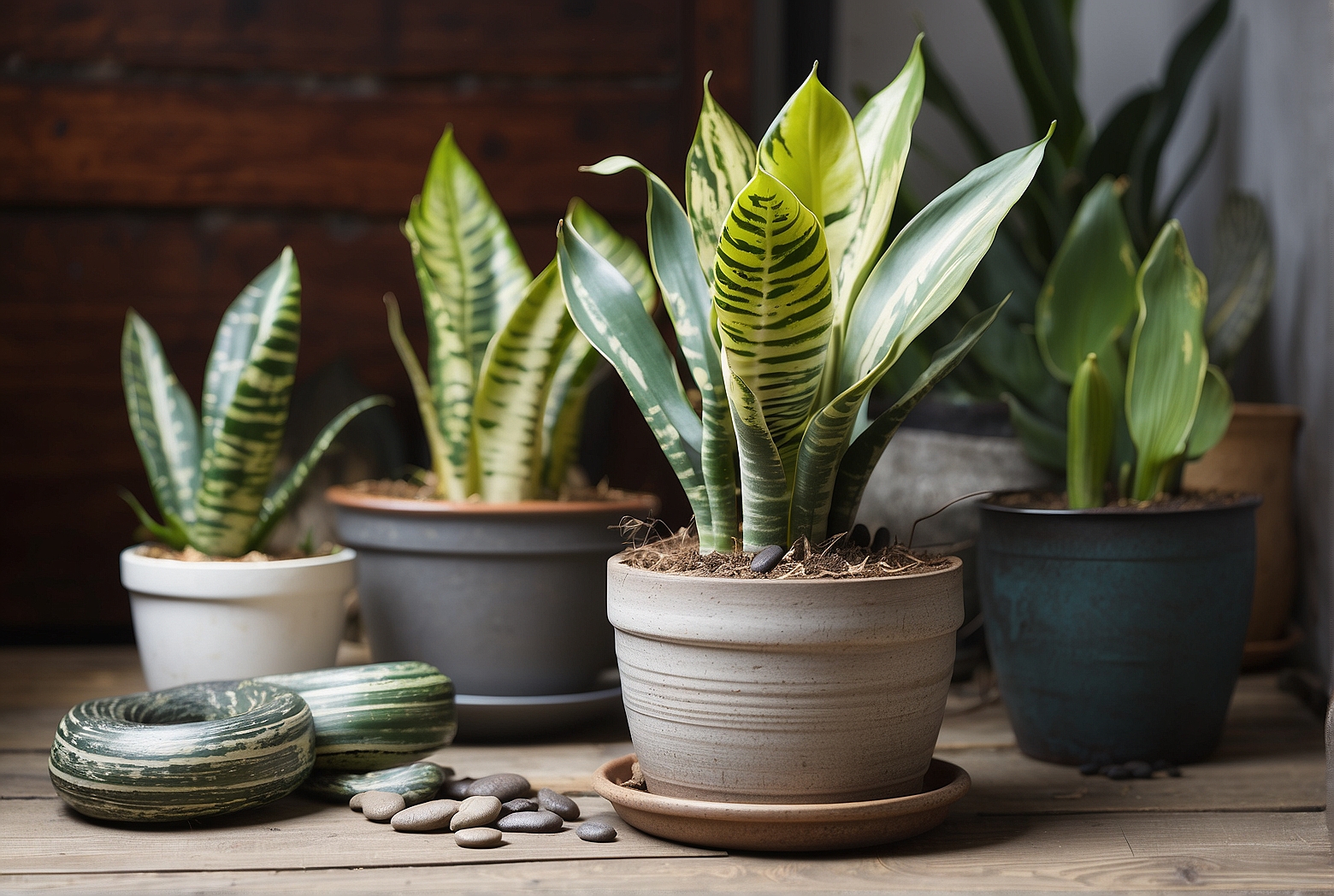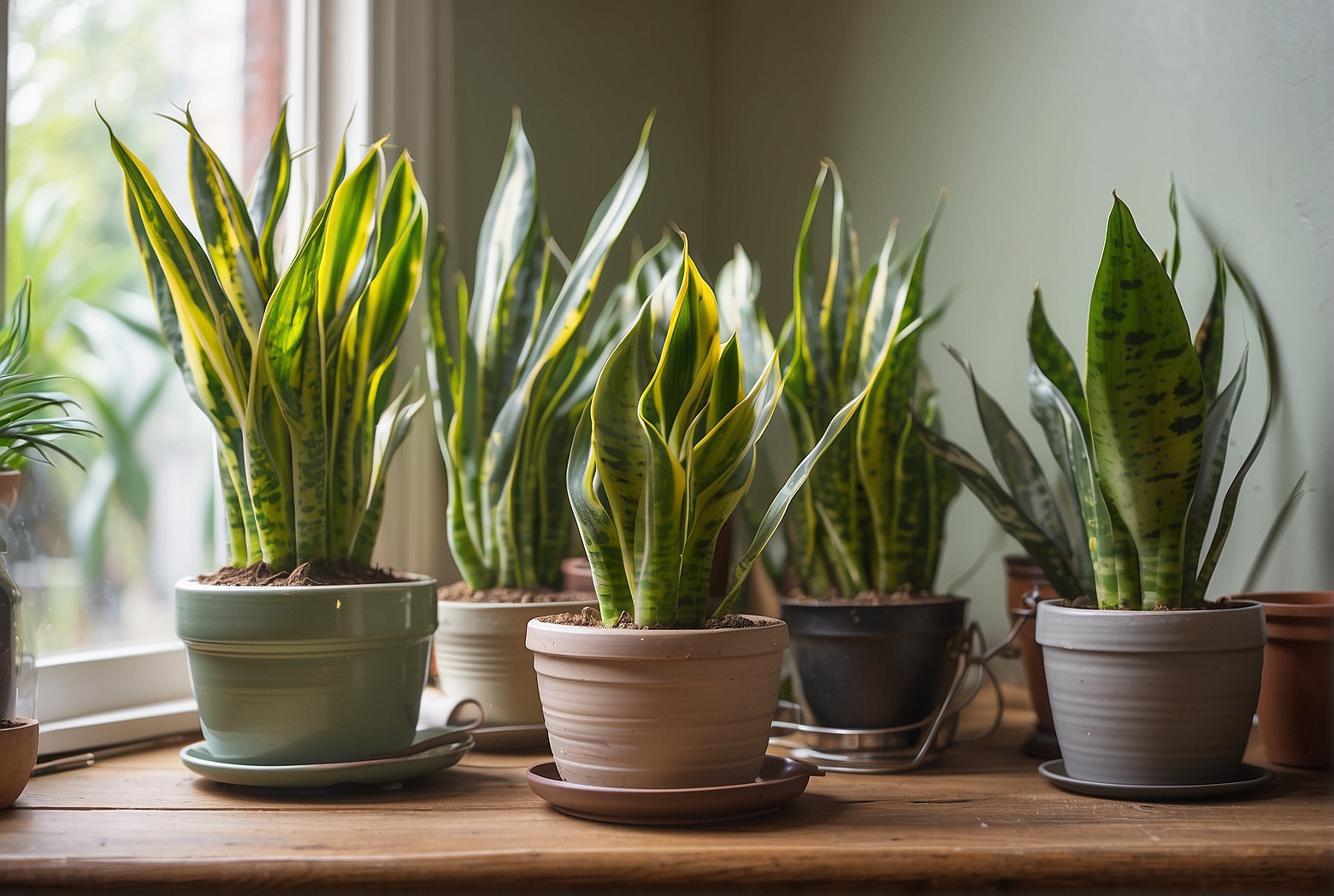Last Updated on April 19, 2024 by Tony Manhart
If you’re a proud owner of a snake plant and want it to thrive and grow at a faster pace, look no further! This article will provide you with simple yet effective tips on how to speed up the growth of your snake plants. From appropriate sunlight exposure to ideal watering techniques, we’ve got you covered. So, let’s unlock the secrets to help your snake plants flourish and reach their full potential.
1. Choosing the Right Pot and Soil
Selecting the Ideal Pot for Snake Plants
When it comes to choosing the perfect pot for your snake plant, there are a few factors to consider. Firstly, select a pot that is slightly larger than the plant’s current container, as this will allow room for growth. Additionally, opt for a pot with drainage holes at the bottom to ensure excess water can easily escape. This helps prevent overwatering and root rot. Lastly, consider the material of the pot. Materials like clay or ceramic are preferable, as they provide better insulation and stability for the plant.
Using Well-draining Soil
Snake plants thrive in well-draining soil that allows water to flow freely. A mixture of potting soil, sand, and perlite provides excellent drainage and aeration for the roots. Avoid dense or compacted soil, as this can lead to waterlogged roots and hinder the plant’s growth.
Considering the Size and Depth of the Pot
The size and depth of the pot play a crucial role in the growth and development of your snake plant. Choose a pot that is deep enough to accommodate the plant’s roots without constraining them. Adequate depth allows the roots to spread out and establish a strong foundation. Additionally, consider the size of the pot in relation to the size of your snake plant. A pot that is too large may retain excess moisture, while a pot that is too small can restrict root growth.

2. Providing Adequate Lighting
Understanding Snake Plant Light Requirements
Snake plants are known for their versatility when it comes to lighting conditions. They can tolerate a wide range of light levels, from low to bright indirect light. However, for optimal growth and to speed up the growth process, providing your snake plant with bright indirect light is ideal. This means placing it near a north or east-facing window where it can receive gentle morning or afternoon sunlight.
Placing the Plant in Optimal Lighting Conditions
To make sure your snake plant gets enough light, position it in a spot that receives bright, indirect light for the majority of the day. Avoid placing it in direct sunlight, as this can scorch the leaves. If natural light is limited in your space, consider using supplemental artificial light. LED grow lights are a great option for providing the right spectrum of light for snake plants.
Supplementing with Artificial Light
If you find that your snake plant is not receiving enough natural light, especially during winter months, you can use artificial grow lights to supplement its lighting needs. Position the lights a few inches above the plant, and aim for a total of 12-14 hours of light each day. This will help promote healthy growth and speed up the growth process.
3. Maintaining the Ideal Temperature and Humidity
Optimal Temperature Range for Snake Plants
Snake plants are adaptable when it comes to temperature, but they prefer temperatures between 70-90°F (21-32°C). Avoid exposing your snake plant to extreme temperatures, such as frost or direct heat sources like radiators. Sudden temperature fluctuations can cause stress and slow down growth.

Avoiding Extremes in Temperature
Extreme cold or hot temperatures can negatively impact the growth of your snake plant. Cold drafts and low temperatures can cause damage to the leaves, while excessive heat can lead to wilting and leaf discoloration. Keep your snake plant away from windows during winter months and ensure it is not placed near heating or cooling sources.
Creating a Suitable Humidity Level
Snake plants are adaptable to different humidity levels, but they thrive in environments with moderate humidity. Aim for a humidity level of around 40-50% to provide optimal growing conditions. To increase humidity, you can place a tray filled with water near the plant or use a humidifier in the room. Avoid misting the leaves directly, as this can increase the risk of fungal diseases.
4. Watering Appropriately
Understanding Snake Plant Watering Needs
Snake plants have low water requirements and are susceptible to root rot if overwatered. It’s important to strike a balance and water your snake plant appropriately. Allow the soil to dry out completely between waterings, and then water thoroughly until water drains out of the bottom drainage holes. It’s better to underwater than overwater a snake plant.
Avoiding Overwatering
overwatering is one of the most common mistakes when caring for snake plants. The roots of snake plants are prone to rot if left sitting in water for extended periods. To avoid this, ensure the pot has proper drainage and never allow your snake plant to sit in standing water. Before watering, check the moisture level of the soil by inserting your finger about an inch deep. If it feels dry, it’s time to water.
Using the Right Watering Technique
When watering your snake plant, it’s important to use the right technique. Water the soil directly at the base of the plant, avoiding the leaves as much as possible. This helps prevent moisture from getting trapped in the foliage, which can lead to fungal diseases. It’s also beneficial to use room temperature water, as cold water can shock the roots and affect growth.
5. Fertilizing to Promote Growth
Choosing the Right Snake Plant Fertilizer
To speed up the growth of your snake plant, it’s essential to provide it with proper nutrients through fertilization. Choose a balanced liquid fertilizer formulated specifically for houseplants. Alternatively, you can opt for a slow-release granular fertilizer to ensure a steady supply of nutrients over time. Avoid using excessive amounts of fertilizer, as this can burn the roots.
Applying Fertilizer at the Right Time and Rate
During the growing season, which typically occurs in spring and summer, fertilize your snake plant every 2-4 weeks. Dilute the fertilizer according to the package instructions and apply it to the soil, avoiding contact with the leaves. Follow the recommended rate to prevent nutrient buildup, which can hinder growth.
Avoiding Excessive Fertilization
While regular fertilization is important, it’s crucial to avoid excessive fertilization. Overfertilization can result in the accumulation of salts in the soil, leading to nutrient imbalances and damage to the root system. If you notice the tips of your snake plant’s leaves turning brown or curling, it may be a sign of fertilizer burn. In such cases, thoroughly flush the soil with water to remove any excess fertilizer.
6. Pruning and Propagation
Trimming Dead or Damaged Leaves
Regular pruning is essential for maintaining the health and appearance of your snake plant. Remove any dead or discolored leaves by cutting them at the base using clean, sharp scissors. Pruning not only improves the overall aesthetics, but it also encourages new growth by redirecting energy to healthier parts of the plant.
Dividing the Snake Plant for Propagation
Propagating snake plants is a great way to promote growth and expand your collection. You can propagate your plant by dividing the root ball into smaller sections. Carefully remove the plant from its pot and gently divide the roots, ensuring each division has a healthy clump of leaves and roots. Repot the divisions into separate pots filled with well-draining soil.
Encouraging Growth by Pruning
In addition to pruning for maintenance purposes, you can also prune your snake plant to encourage growth. If you notice the plant becoming too tall or leggy, trim the taller leaves near the base. This redirects energy to the remaining leaves and promotes new growth from the base of the plant. Regular pruning helps maintain a compact and bushy appearance.
7. Protecting Against Pests and Diseases
Identifying Common Snake Plant Pests
While snake plants are generally resilient and pest-resistant, they can occasionally fall victim to common houseplant pests. Look out for signs of spider mites, mealybugs, or scale insects. Spider mites cause webbing and stippled leaves; mealybugs appear as cottony clusters on plant parts; scale insects resemble small bumps on the leaves or stems.
Taking Preventive Measures
Prevention is key when it comes to pest infestations. Inspect new plants before bringing them indoors and quarantine them if necessary. Maintain good hygiene by regularly cleaning the leaves with a soft cloth or sponge. Ensure proper airflow and avoid overcrowding, as pests thrive in stagnant conditions. Finally, avoid overwatering, as excessive moisture can attract pests.
Treating Pest Infestations
If you do encounter a pest infestation, there are several treatment options available. For small infestations, you can try wiping the affected areas with a cotton swab dipped in rubbing alcohol. Alternatively, insecticidal soap or neem oil can be effective in controlling pests. Follow the instructions on the product label and repeat treatments as necessary until the infestation is eradicated.
8. Avoiding Common Pitfalls
Preventing Root Rot
Root rot is a common issue that can hinder the growth of snake plants. To prevent root rot, ensure your plant is potted in well-draining soil and that the pot has drainage holes. Avoid overwatering and allow the soil to dry out between waterings. If you suspect root rot, carefully remove the plant from its pot and inspect the roots. Trim away any soft, mushy, or discolored roots and repot the plant in fresh, dry soil.
Monitoring for Overcrowding
Snake plants have a tendency to spread and can become overcrowded if not monitored. Overcrowding can lead to root competition, nutrient deficiencies, and stunted growth. Keep an eye on your snake plant and consider dividing it into multiple pots if it becomes too crowded. Ensure each plant has enough space to grow and thrive.
Avoiding Mistakes in Watering and Lighting
Mistakes in watering and lighting can greatly impact the growth of your snake plant. Avoid overwatering by allowing the soil to dry out between waterings and using the appropriate watering technique. Ensure your plant receives adequate bright, indirect light and is not exposed to direct sunlight. By avoiding these common pitfalls, you can provide optimal conditions for your snake plant to grow and thrive.
9. Providing Adequate Air Circulation
Avoiding Stagnant Air
Stagnant air can lead to a buildup of moisture and increase the risk of fungal diseases in snake plants. Ensure proper air circulation in the room by opening windows or using fans to keep the air moving. Avoid placing your snake plant in areas with poor airflow, such as closed-off corners or rooms with limited ventilation.
Placing the Plant in Well-ventilated Areas
To promote optimal growth, choose well-ventilated areas for your snake plant. Areas with good airflow allow carbon dioxide to dissipate and fresh oxygen to circulate around the plant. This aids in the plant’s respiration and overall health. Avoid positioning your snake plant in enclosed spaces or areas with limited air movement.
Using Fans or Open Windows
If you notice stagnant air around your snake plant, consider using fans or opening windows to improve air circulation. Place a small, oscillating fan near the plant to keep the air moving. If weather conditions permit, open windows to allow fresh air to enter the room. Good air circulation helps prevent the buildup of excess moisture and promotes healthy growth.
10. Giving the Plant Enough Time
Understanding the Growth Rate of Snake Plants
Snake plants are known for their slow but steady growth. It’s important to have realistic expectations and understand that significant growth may take time. The growth rate can vary depending on various factors such as light, temperature, and overall care. On average, you can expect a snake plant to grow a few inches per year.
Patience and Consistency in Care
Patience is key when it comes to the growth of snake plants. Provide consistent and appropriate care, including proper watering, lighting, and fertilization. Avoid making drastic changes to the plant’s environment, as this can cause stress and hinder growth. With time and consistent care, your snake plant will thrive and reach its full potential.
Avoiding Stressful Transitions
Transitions can be stressful for snake plants and can slow down their growth. Avoid moving the plant frequently or exposing it to abrupt changes in lighting or temperature. When repotting or propagating, handle the plant gently to minimize stress. By providing a stable and consistent environment, you can help your snake plant grow at its natural pace.
In summary, to speed up the growth of your snake plant, it’s important to choose the right pot and soil, provide adequate lighting, maintain the ideal temperature and humidity, water appropriately, fertilize properly, prune and propagate as needed, protect against pests and diseases, avoid common pitfalls, ensure adequate air circulation, and give the plant enough time to grow. By following these guidelines and providing optimal care, you can help your snake plant thrive and achieve its maximum growth potential.
Tony Manhart is a passionate gardener who has been tending to gardens for over 20 years. He takes pride in creating beautiful outdoor spaces with plants, trees, and shrubs that can thrive in any environment. He loves to share his knowledge with others and has taught classes on gardening basics and advanced techniques. He is committed to sustainability, using natural and organic methods to create and maintain gardens. He also works with local organizations to create green spaces for communities. When he’s not gardening, Tony enjoys hiking, reading, and spending time with his family.


